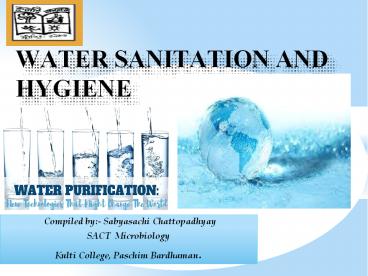Water sanitation and hygiene - PowerPoint PPT Presentation
Title:
Water sanitation and hygiene
Description:
The presentation is about purification of water and related issues of consumption of impure water. – PowerPoint PPT presentation
Number of Views:1224
Slides: 28
Provided by:
Username withheld or not provided
Category:
Medicine, Science & Technology
Tags:
Title: Water sanitation and hygiene
1
WATER SANITATION AND HYGIENE
Compiled by- Sabyasachi Chattopadhyay SACT
Microbiology Kulti College, Paschim Bardhaman.
2
INDEX
Spring
8. CONCLUSION
3
1.INTRODUCTION
4
1.1 Water
- 71 of the earths surface.However only 3 water
is freshwater out of which 1.2 is usable and
97 water remains in the sea in the form of
saline water.
5
1.2 Natural water Supplies
Surface water
Underground water
River lakes
Rain water
2 layers shallow deep
Spring
Easily polluted so needs purification.
Pick impurities
Sea water
Pure if protected
Sterile if sanitary precautions are followed
Desalination is expensive
6
1.3 Uses of water
7
2.
8
Water pollution is any physical, biological
chemical changes in water quality that adversely
affects living organisms (man, animal and fish)
or make water unsuitable for desired uses.
9
Hygiene
- Hygiene is defined as the practice of keeping
oneself and ones surrounding clean in order to
prevent disease. - Sanitation
- Sanitation is defined as the arrangements to
protect public health and the provision of safe
and clean drinking water and proper disposal of
sewage.
10
Biological
3. Sources of contamination of water
Water soluble inorganic chemicals
Organic chemicals
Oxygen demanding wastes
Sediment or suspended matter
Radioactive isotopes
11
4. WATER BORNE DISEASES
- 1.Caused by presence of Infective agent
- ViralViral hepatities A,Hepatities
E,poliomyelitis,Rotavirus diarrhoea. - Bacterial Typhoid,Para typhoid fever,bacillary
dysentery E.coli diarrhoea,cholera, trachoma.
12
- Protozoal
- Amoebiasis,giardiasis
- HelminthicRoundworm ,Hydatid diseases
- Snail fever or Schistosomiasis
- Aquatic animals that form a necessary part of
life cycle of infecting agent. - Induced by insects that breed in water.
egmalaria , filariasis
13
4.1 HUMAN HEALTH AND WATER
- Diarrheal disease alone is responsible for the
death of 1.8 million people every year (WHO
2004). - It was estimated that 88 of the burden is
attributable to unsafe water supply and
sanitation.
14
Malaria
15
Trachoma
- 6 million are visually impaired by trachoma.
Intestinal helminthes(Ascariasis,Hookworm)
16
Japanese Encephalitis
Hepatitis A
Hepatitis A is a viral liver disease that can
cause mild to severe illness. The hepatitis A
virus (HAV) is transmitted through ingestion of
contaminated food and water or through direct
contact with an infectious person. Almost
everyone recovers fully from hepatitis A with a
lifelong immunity.
17
5.
18
Physical
Biological
Chemical
Water examination for physical, chemical
bacteriological standards is carried out at each
step of water purification.
19
Physical standards
- Must be odourless, colourless, agreeable taste
and clear. - Presence of organic matter, algae, silt and mud
can alter water's physical characteristics
(becomes turbid, changes odour).
20
Chemical standards
pH must be neutral or slightly alkaline. - With a
moderate degree of hardness.
Safety limits for some chemicals are
determined such as nitrate 1.0 ppm, 0.6 ppm
fluoride 0.3 ppm iron , arsenic lead must be
nil.
21
Bacteriological standards
- It concentrates on evidence of faecal
pollution. - Water is inoculated on agar other
special media. - coliform bacteria (commonly
referred as fecal coliforms) are the group most
frequently used as indicators of fecal
pollution. - A high coliform count of is regarded
as being suspicious of fecal pollution. No ova,
no cysts or parasites.
22
6.
23
(No Transcript)
24
INITIATIVES
- Providing equitable community access to safe
water, improved sanitation, and hygiene. - Strengthening the ability of communities to
develop, fund, and maintain sustainable water and
sanitation systems. - Supporting programs that enhance community
awareness of the benefits of safe water,
sanitation, and hygiene. - Supporting studies for career-minded
professionals related to water and sanitation .
25
CONCLUSION
We must remember that the world is not only for
us but also for our future generations . So it
is our duty to leave a fresh environment for our
future generations to come. We must keep in mind
not to waste or to make our valuable water
resources unsafe and conserve water as far as
possible.
26
References-
1. Erach Bharucha Textbook of Environmental
Studies for Undergraduate Courses Second edition
ISBN-13 978-8173718625
2. https//www.google.com/search?qwaterbornedis
eases
3. https//www.google.com/search?qagriculturalus
ewater
4. https//www.who.int/health-topics/water-sanitat
ion-and-hygiene-wash
5.https//www.google.com/search?qslidesharesourc
elmnsbih654biw1366client-b-dhlenUSsaXve
d2ahUKEwiVzZDtucHvAhUFZSsKHZA7COkQ_AUoAHoECAEQAA
27
THANK YOU































